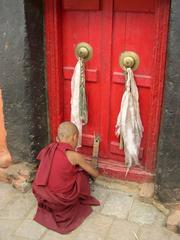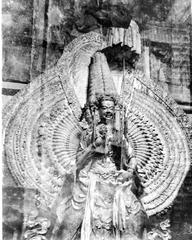Central Asian Museum Leh: Visiting Hours, Tickets, and Complete Guide to Historical Sites in Leh
Date: 14/06/2025
Introduction
The Central Asian Museum in Leh, Ladakh, stands as a vivid testament to the region’s legacy as a crossroads of civilizations along the ancient Silk Road. Situated in the historic Tsas Soma complex, the museum encapsulates centuries of trans-Himalayan trade, cultural exchange, and artistic syncretism that shaped Ladakh’s multicultural identity (Stok Palace Heritage; Domus). Architecturally inspired by Central Asian fortress towers and built using local granite and timber, the museum immerses visitors in Ladakh’s unique architectural tradition (Tibet Heritage Fund).
The museum’s collections vividly narrate the Silk Road era through ancient coins, textiles, manuscripts, trade artifacts, and religious objects, offering insight into the interconnected histories of Ladakh, Tibet, Kashmir, and Baltistan (Central Asian Museum Leh; Travelling Camera). With accessible visiting hours, affordable tickets, and a range of educational programs, the museum stands as a vibrant cultural hub for both locals and travelers (Lonely Planet).
This detailed guide covers everything you need to plan your visit, from historical context and architectural highlights to practical visitor tips and nearby attractions.
Contents
- Overview: History and Cultural Significance
- Architectural Highlights and Regional Identity
- Collections and Permanent Exhibits
- Visiting Hours, Tickets, and Accessibility
- Visitor Tips and Nearby Attractions
- Educational, Cultural, and Community Engagement
- FAQ: Plan Your Visit
- Sustainability and Responsible Tourism
- References
History and Cultural Significance
Origins and Vision
Conceived in the early 2000s by Saleem Beg of INTACH J&K and the Anjuman Society, with support from the Tibet Heritage Fund and Government of Jammu and Kashmir, the Central Asian Museum opened in phases between 2011 and 2016. Its mission: to foster cross-cultural dialogue and tolerance in a region historically shaped by shifting borders and diverse influences (Stok Palace Heritage; Domus).
The museum’s location in the Tsas Soma complex, once a caravanserai and the site of Leh’s oldest mosque, reflects Leh’s pivotal role in trans-Himalayan trade and its multicultural past.
Ladakh: Crossroads of Civilizations
For centuries, Leh was a vital hub on the Silk Road, connecting Turkestan, Tibet, Kashmir, Baltistan, and the Indian subcontinent (Travelling Camera). Traders and pilgrims exchanged goods, ideas, religious beliefs, and artistic traditions, making Leh a cosmopolitan center. The museum preserves the memory of this era, especially as geopolitical changes in the 20th century isolated Ladakh from its neighbors (Domus).
Architectural Highlights and Regional Identity
Design and Construction
The museum’s four-story structure draws inspiration from traditional Central Asian fortress towers, employing local granite from Shey and Tibetan-Ladakhi building techniques such as thick masonry walls and carved wooden pillars (Domus). Local artisans crafted every detail, supporting Ladakh’s craftsmanship and economy.
Site Layout
Located in the oasis-like Tsas Soma Gardens, adjacent to Leh’s oldest mosque, the museum is shaded by willow trees and traversed by a traditional water channel (Tibet Heritage Fund). Each floor is dedicated to a region—Ladakh, Kashmir, Tibet, and Baltistan—offering panoramic views of Leh from the top gallery.
Collections and Permanent Exhibits
Silk Route Artifacts
The museum’s galleries illustrate Ladakh’s pivotal role in Silk Route trade through:
- Ancient Coins and Currency: From Tibet, Yarkand, Kashgar, and Central Asia (Travelling Camera; Thrillophilia).
- Textiles and Garments: Traditional Ladakhi robes and finely embroidered Central Asian clothing.
- Trade Instruments: Weighing machines, abacuses, and trade records.
Manuscripts and Documents
- Handwritten Qurans: Including a rare chronology of the Prophet Muhammad (Thrillophilia).
- Trade Records, Maps, and Letters: Documenting commercial agreements and perilous journeys.
- Multilingual Manuscripts: In Persian, Tibetan, and Balti scripts.
Textiles and Carpets
- Yarkandi Carpets: Donated by Central Asian traders, reflecting intricate craftsmanship (Central Asian Museum Leh).
Everyday Life and Domestic Artifacts
- Traditional Kitchen Reconstruction: Historic culinary utensils and a caravan water heater (Thrillophilia).
- Household Items and Jewelry: Illustrating daily life in Ladakh.
Photographs and Visual Documentation
- Historic Photographs: Showing traders, caravans, and early 20th-century Leh.
- Trade Route Maps: Charting Silk Road pathways through Ladakh (Ju-Leh Adventure).
Community Contributions
Artifacts are often donated by local families and the Sunni Muslim community, especially via the Leh Jamia Masjid (Central Asian Museum Leh).
Visiting Hours, Tickets, and Accessibility
Visiting Hours
- Regular: 10:00 AM to 5:00 PM daily, closed on major public holidays.
- Best Season: May–September for optimal weather (TravelTriangle).
Ticket Prices
- Indians: INR 100
- Foreigners: INR 300
- Children under 12: Free
- Students/Senior Citizens: INR 50 (with valid ID)
- Discounts: Available for groups and educational visits.
Accessibility
- Wheelchair Access: Available on the ground floor. Upper floors are accessible by stairs; staff assistance provided on request.
- Entrances: From Main Bazaar and Old Town, with clear signage.
- Facilities: Restrooms, seating, and a planned garden café.
Visitor Tips and Nearby Attractions
Planning Your Visit
- Footwear: Wear comfortable shoes for uneven terrain and stairs.
- Crowds: Mornings and late afternoons are less busy.
- Weather: Dress in layers; Leh’s climate can be cool, even in summer (Wanderlog).
- Altitude: Acclimatize for a day before strenuous activity.
Nearby Attractions
- Leh Palace: 180 meters away, a nine-storey historic palace.
- Jamia Masjid: 80 meters away, a 17th-century mosque.
- Leh Old Town: 150 meters away, full of traditional houses and winding alleys.
- Chokhang Vihara & Chamba Lhakhang: Within walking distance.
- Main Bazaar: For shopping handicrafts and local cuisine.
Educational, Cultural, and Community Engagement
Research and Library
The Trans-Himalayan Research Library houses books and documents on Ladakh and neighboring regions, serving scholars and interested visitors (Stok Palace Heritage).
Cultural Performances
The museum occasionally hosts traditional music and dance performances, reinforcing Leh’s pluralistic heritage (Travelling Camera; Evendo).
FAQ: Plan Your Visit
Q: What are the museum’s visiting hours?
A: 10:00 AM to 5:00 PM, closed on major holidays.
Q: How much are tickets?
A: INR 100 (Indian), INR 300 (foreigners), free for children under 12.
Q: Is the museum wheelchair accessible?
A: The ground floor is accessible; upper floors are via stairs.
Q: Are guided tours available?
A: Yes, on request and highly recommended for deeper understanding.
Q: Is photography allowed?
A: Permitted without flash; restrictions apply to some exhibits.
Q: Are permits required?
A: No permit needed for Leh or the museum; required for certain Ladakh areas (Thrillophilia).
Sustainability and Responsible Tourism
- Dress modestly and respect local customs, especially near religious sites.
- Support local vendors by purchasing tickets, food, and handicrafts on-site.
- Behave respectfully in this culturally and religiously significant area.
Summary Table: Key Collection Categories
| Collection Type | Notable Items/Features |
|---|---|
| Trade Artifacts | Pottery, stone tools, bronze items, coins, weighing machines, abacuses |
| Manuscripts | Handwritten Qurans, trade records, multilingual manuscripts |
| Textiles | Yarkandi carpets, traditional Ladakhi fabrics |
| Domestic Artifacts | Ladakhi kitchen, caravan water heater, utensils |
| Visual Documentation | Historic photographs, trade route maps |
| Community Donations | Artifacts from Leh Jamia Masjid, local family heirlooms |
| Architectural Elements | Fortress tower design, Gandhara-style masonry, spiral staircase, Tsas-Soma garden |
Conclusion
The Central Asian Museum in Leh is a must-visit destination for anyone seeking to understand the Silk Road’s enduring legacy and Ladakh’s multicultural past. With its thoughtful exhibitions, immersive architecture, and dynamic cultural programs, the museum offers a meaningful and accessible experience for all visitors. Combine your visit with nearby historical sites, take advantage of guided tours, and explore the vibrant culture of Leh.
For the latest hours, ticket info, and special exhibits, visit the official museum website. Download the Audiala app for interactive guides and travel tips, and follow the museum’s social media channels for updates on exhibitions and cultural events.
References
- Stok Palace Heritage
- Domus
- Travelling Camera
- Central Asian Museum Leh
- Tibet Heritage Fund
- Lonely Planet
- TravelTriangle
- Thrillophilia
- Ju-Leh Adventure
- Wanderlog
- Evendo

